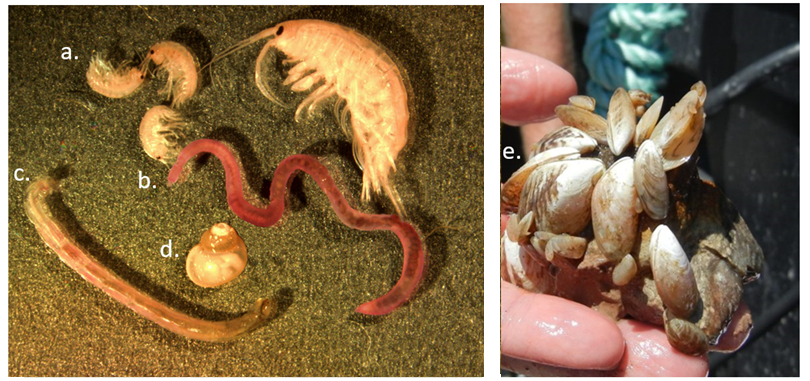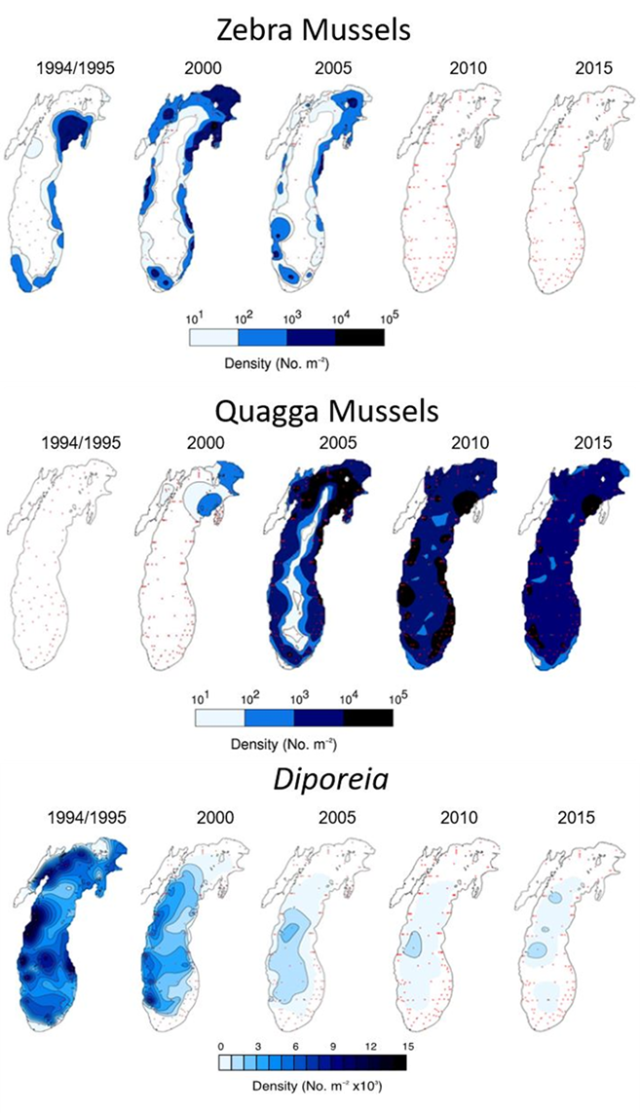Great Lakes Benthic Invertebrate Monitoring
On this page:
- What are benthic invertebrates?
- Why are benthic invertebrates important for the Great Lakes?
- How has the benthic community changed?
What are benthic invertebrates?
Benthic macroinvertebrates are small aquatic animals that live on the bottom of lakes, rivers, and oceans.
Types of benthic macroinvertebrates collected in the Great Lakes include:

- Crustaceans(amphipods such as Diporeia and isopods) (a)
- Worms and leeches (b)
- Insect larvae (mayflies and midges) (c)
- Snails (d)
- Clams and mussels (e, note: image shows invasive quagga mussels)
Benthic invertebrates can be collected from the bottom of the Great Lakes using a Ponar grab sampler and a benthic sled. The Ponar traps sediment and invertebrates as it claps shut on the bottom of the lake, and the benthic sled scoops up organisms into a net as it is dragged along the lake bottom. Scientists also attach cameras to a benthic sled and camera frame to obtain video of the lake bottom.
Why are benthic invertebrates important for the Great Lakes?
Benthic invertebrates play vital roles in food webs , nutrient cycles, and serve as indicators of environmental change. These organisms are an important component of fish diets, and many are detritivores, feeding on setting decaying organic material and returning that energy to the food web. Due to their place in the food web and the fact that these organisms live directly in lake sediments, benthic invertebrates connect water column and benthic nutrient cycles through their consumption of organic material and disturbing sediments, which allow nutrients to return to the water column.
Scientists also examine changes to benthic invertebrate communities as an indicator of environmental change because they are easy to collect and differ in their tolerance to pollution. Benthic invertebrates also have limited mobility, so changes in the benthic community reflect changes to their immediate surrounding environment. Currently, benthic organisms are used as indicators of ecosystem health for the Great Lakes in the binational State of the Great Lakes Reports issued by the United States and Canada.

How has the benthic community changed?
Changes to the benthic community have occurred in Lakes Michigan, Huron, Erie, and Ontario in recent decades due to the invasion of dreissenid (zebra and quagga) mussels. These mussels are now the most abundant benthic organism in Lakes Michigan and Ontario. Low calcium concentrations in Lake Superior waters prevent dreissenids from densely colonizing the lake bottom because mussels need calcium for shell formation. As a result, there has been relatively little change to the Lake Superior benthic community since the late 1990s.
Zebra and quagga mussels are filter feeders that densely colonize benthic environments, leading to significant changes to ecosystem function, including increased light penetration, changes to nutrient cycles, and declines in phytoplankton abundance. As invasive dreissenid populations expanded, there were large decreases in amphipods (crustaceans) in Lakes Michigan, Huron, and Ontario, primarily driven by a decline in the amphipod Diporeia. Diporeia were historically the dominant benthic invertebrate in the offshore regions, serving as a key food source for many fish species. As zebra and quagga mussels expanded in the lower four Great Lakes, Diporeia declined, potentially due to food limitation caused by competition with dreissenid mussels; however, scientists are still uncertain about the exact cause of the decline.


